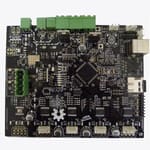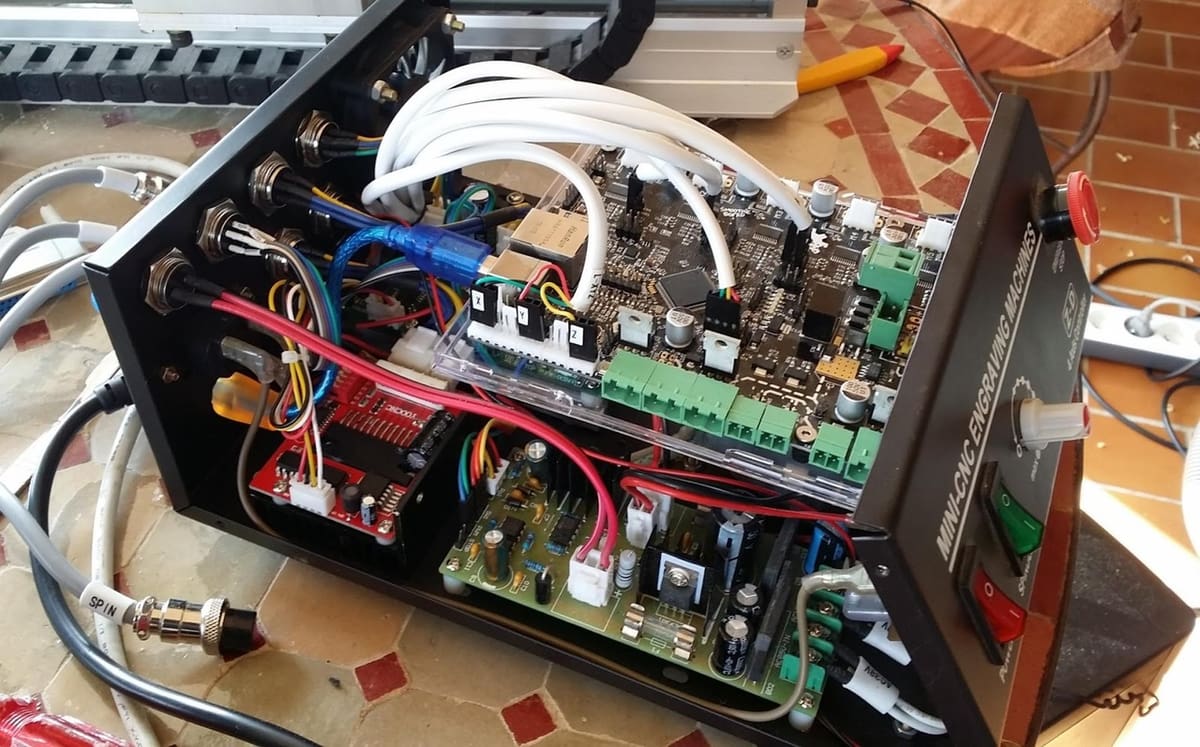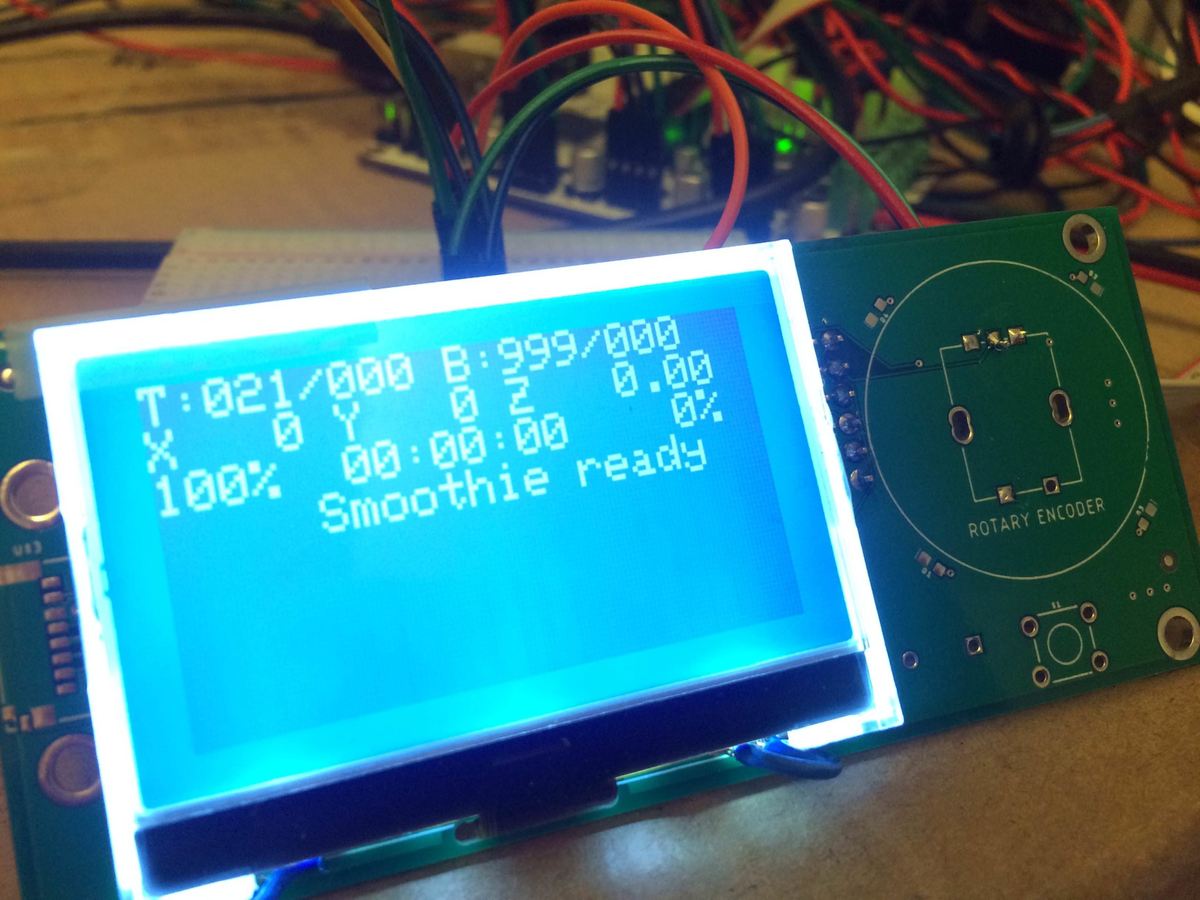Mainboards, also known as controller boards, are the lifeline of 3D printers, allowing you to control your machine’s different parts. They’re a vital element of a printer but are often overshadowed by other flashier features.
In the past, most 3D printers used 8-bit mainboards, which are cheap and function just fine. However, 8-bit boards lack the processing power and capabilities of their big brothers, 32-bit boards.
Although 32-bit boards are usually more expensive than their 8-bit counterparts, they have increased in popularity with the advent of more advanced firmware packages, which have more features. Most 8-bit boards, due to their limited computing power and speeds, can’t exercise the full potential of newer, more advanced firmware.
The Smoothieboard v1 is one of these newer 32-bit boards, and aside from having a lot of power, it also has a plethora of different ports. The board was developed by Smoothieware, a growing mainboard and machine firmware company that makes the popular Smoothieware firmware. Initially crowdfunded on Kickstarter, the project received considerable support and exceeded its target goal by more than $90,000.
In a Nutshell
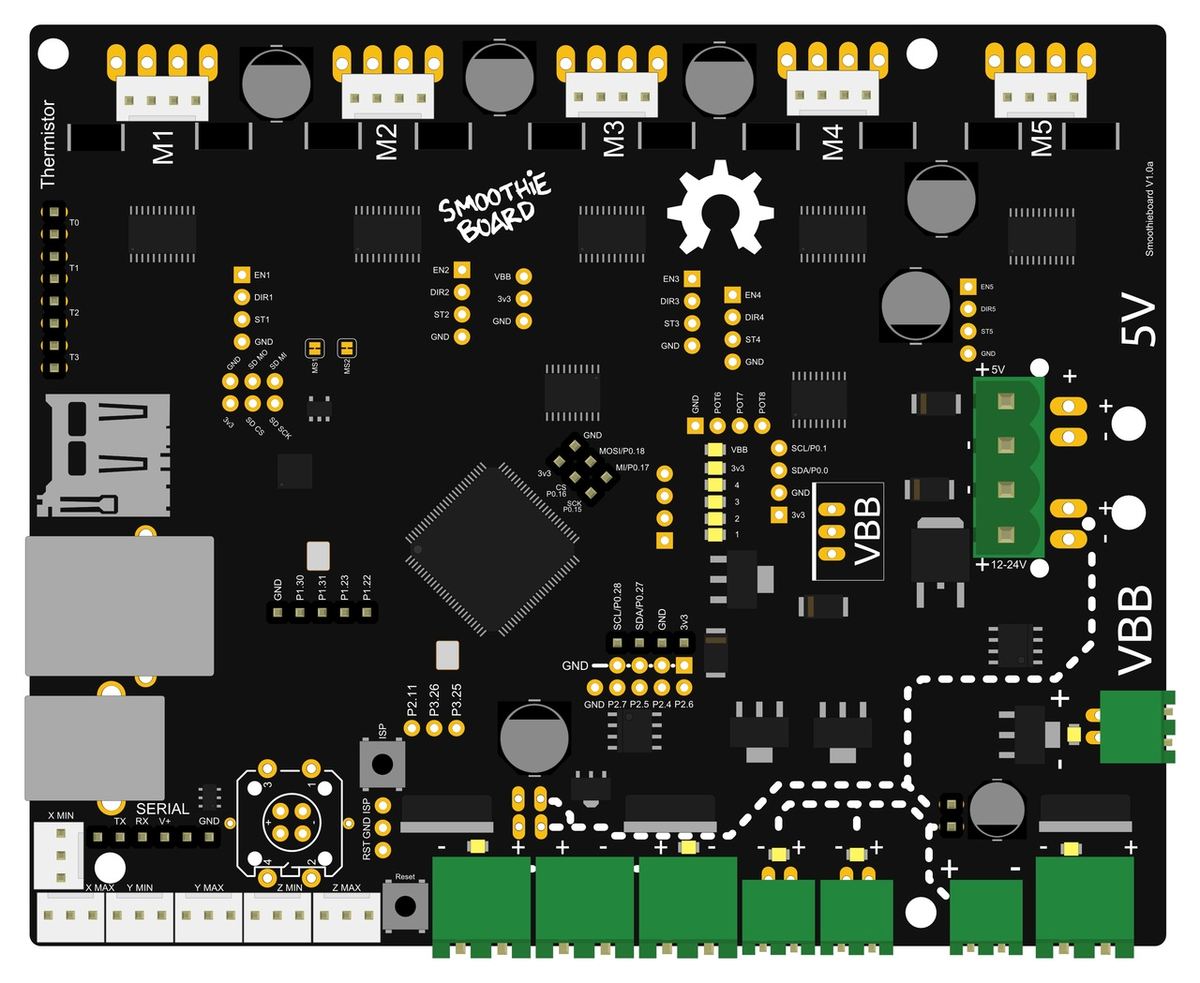
At around $200, the Smoothieboard v1 is pretty expensive for a mainboard, especially when you can get some lower-quality boards for under $20. That being said, it has a reputation as a high-quality control board for machines and can be found in 3D printers, CNC machines, and laser engravers, among others.
The Smoothieboard v1 is an action-packed single-board computer (SBC), which is essentially a complete computer on one circuit board. It also features open-source hardware, meaning that it’s compatible with third-party hardware, and it has a boatload of features.
In the following sections, we’ll go over what the Smoothieboard has to offer, its specifications, and where you can buy it.
Let’s get started!
Features
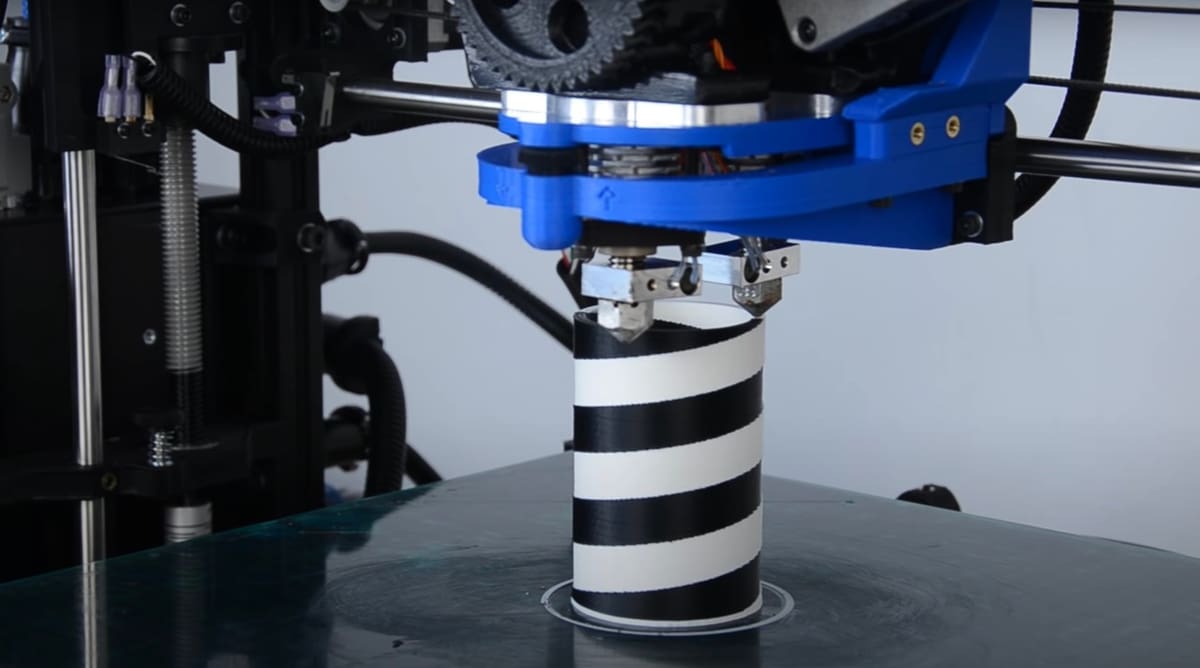
The Smoothieboard v1 isn’t your average Raspberry Pi: It’s designed to control entire machines. This means the board has to be full of ports for sensors, motors, a screen, interface options, and more. We’ve split up this section into a few distinctive categories to discuss these points.
Machine Ports
Thanks to the number of ports it has, a board like the Smoothieboard v1 is more than well equipped to handle a basic 3D printer. Partly this is possible due to its size. As it’s much larger than some of the other 3D printer mainboards, the Smoothieboard has more space for ports.
Stepper Motors
The board comes in a few different variations, each having an additional amount of stepper motor ports. The 3X, 4X, and 5X versions have three, four, and five stepper motor drivers, respectively. Each one is an Allegro A5984 with 1/32 micro-stepping abilities.
You also have the option of connecting the Smoothieboard to external stepper drivers; up to five external drivers can be accommodated. If you’re using the board to control a printer, you could theoretically install a driver like the popular TMC2208 or 2205 to keep your motors quiet as long as you adjust your firmware to process these drivers.
Endstops
Along with the stepper motor drivers, the Smoothieboard has six endstop ports, which can be used to create boundaries for your printer’s axis. Typically, a printer has one endstop on one side of each axis. An endstop port can also work with a Z-probe for bed leveling, such as the BLTouch.
Mosfets
The Smoothieboard includes a total of six field-effect transistor (FET) ports, which are also known as Mosfet ports. Of the six, three are considered large Mosfets, meaning they can handle components with higher loads, like heated beds or powerful hot ends. The other three Mosfet ports are small Mosfets and are meant to power smaller load parts, such as fans and regular hot ends. All together, you have plenty of space for two hot ends.
While, technically, you could have a maximum of six hot ends, you would only be able to actually use two hot ends. This is due to the fact that most 3D printers use three motors to control motion along the X-, Y-, and Z-axes, leaving you with only two spare motors for extruders to push filament through the hot ends.
Thermistors
Four thermistor ports are also included on the board. Thermistors read temperatures and are primarily used on heated beds and hot ends but can also be used for enclosures or heated chambers to measure the room temperature.
Interface Ports
The Smoothieboard v1 has a few different interface ports. And by “interface ports”, we mean ports that allow you to interact with the board.
The Ethernet port connects the board to local area networks (LAN), which creates the possibility for you to control it via an internet platform (website). This board also has a USB Type-B port, which most paper printers use for a connection. If you adjust your Smoothieware firmware for this feature, you could use this port to print from your device.
Like many 3D printer control boards, a Micro SD card slot is included on the board. This feature is prevalent because it’s a simple way for users to print from the inserted media without depending on any network (like LAN or Wi-Fi).
The Smoothieboard also has an LCD port, which enables you to attach a regular or touchscreen (TFT) display. This port may seem insignificant, but 3D printers and other machines that lack an LCD screen can be a pain to control, especially when you don’t have a portable or nearby device to use.
Computing
The Smoothieboard v1 is equipped with a 32-bit ARM-Cortex M3 microcontroller, which is a good deal faster than your typical motherboard. Specifically, the board has a transmission speed of 120 MHz, while a typical ATMega2560, which is featured on many inexpensive 3D printer boards, runs at a speed of 16 MHz. This means the board can transmit data – G-code scripts for a 3D print, for example – much faster than your typical board, and the UI on your printer will be quicker, as well.
The ARM-Cortex M3 processor has 64 KB of memory (SRAM), significantly more than the 8 KB of memory on the ATMega2560. This also contributes to the board’s processing power and will increase the speeds of on-board actions, such as reading the Micro SD card.
EEPROM is the on-board storage for a control board, and outside of the 3D printing universe, it’s known as flash memory. The Smoothieboard has 512 KB of flash memory, which means you can activate many features on your firmware and save them to the board.
Firmware
A mainboard’s firmware deciphers software into instructions to control your machine. It also provides you with an interface to manage the machine, like offering buttons on the machine’s display screen to set temperatures.
In the case of the Smoothieboard, the firmware carries the same name as the company: Smoothieware. Though a capable architecture, it’s sadly the only firmware that the Smoothieboard can run; other firmware options like Marlin are incompatible. Smoothieware, however, is open source, so if you’re capable, you can change the programming using software like PlatformIO to add on or activate additional features.
The Smoothieboard is optimized to run Smoothieware, so it functions very well on this board. As open-source firmware, it’s constantly being updated on GitHub by a whole community dedicated to improving it.
Smoothieware is compatible with interfaces like OctoPrint and Pronterface and has improved motion control to keep a printer running smoothly. Unlike many of the other firmware options, it has PID auto-tuning, which ensures that your hot end is running correctly. The company also reports that Smoothieware supports all features found in RepRap firmware.
The Bottom Line
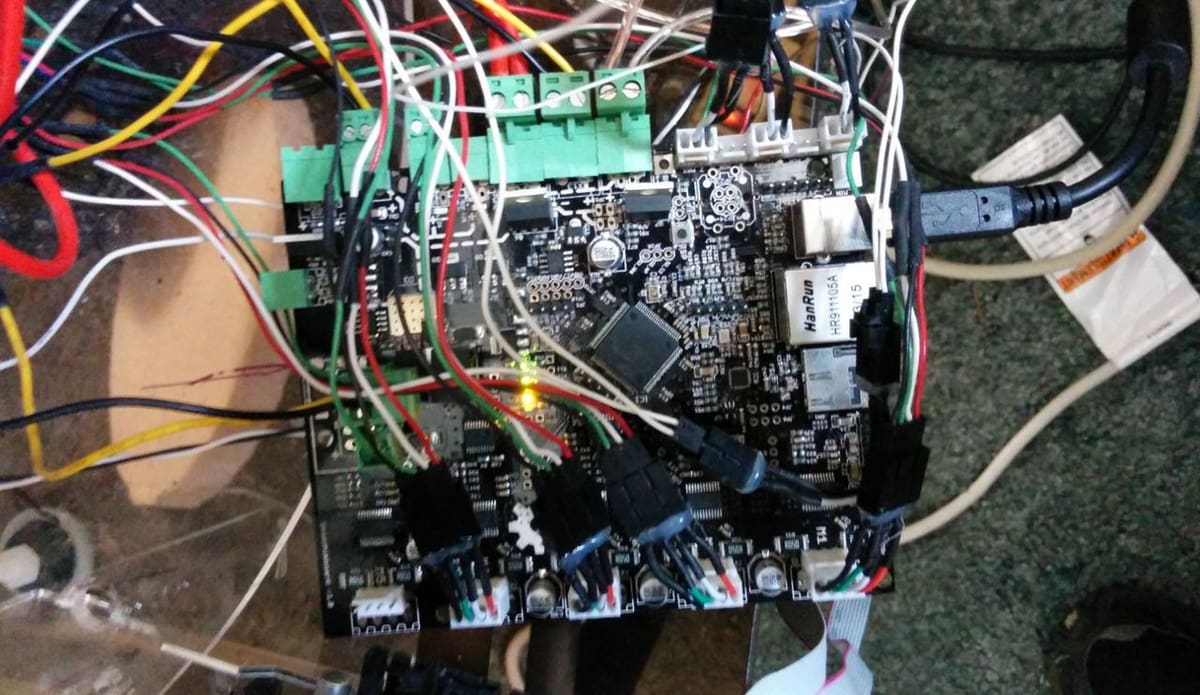
Now you know that the Smoothieboard v1 is a powerful beast, but is it worth the expensive price tag? To help get an answer to this question, it’s important to compare the features of the Smoothieboard v1 to other 3D printer mainboards.
Hardware
A comparable SBC is the Duet3D 6HC mainboard, which is a similarly-priced machine mainboard. In comparison, the Smoothieboard seems a little lacking in Mosfet and sensor ports. The 6HC has a total of nine Mosfet ports (small and large), while the Smoothieboard v1 only has six (three small and three large).
Where the Smoothieboard has six endstop sensor ports, the Duet3D 6HC has nine. The latter also boasts the ability to work with other types of sensors, like a filament runout sensor.
With four thermistor ports and five stepper motor drivers, a 3D printer controlled by a Smoothieboard without additional stepper drivers could only have two functional hot ends. That’s because a printer typically has one motor for each axis (X, Y, and Z), and for each hot end, an extruder motor is needed to push the filament through the hot end.
Unfortunately, the Smoothieboard doesn’t have a micro-USB port, which seems to be a popular choice among mainboards nowadays. The Smoothieboard is still using the somewhat outdated USB type-B for serial interface connections, but they also have an Ethernet and Micro SD card port, which kind of makes up for that.
In fact, the Ethernet port is particularly advantageous for the Smoothieboard v1, as most mainboards either have no internet connection or only support a Wi-Fi connection. Wireless is great, but an Ethernet LAN connection is more stable and reliable.
Software
A major benefit of buying a Smoothieboard is the fact that Smoothieware, who makes firmware, built the board. Hence, the Smoothieboard is more compatible with Smoothieware firmware than the Duet3D 6HC or any other board. Though the Smoothieboard isn’t compatible with third-party firmware, Smoothieware itself is open source, and you can edit it to add any features you want.
Both the v1 and the 6HC are very power-heavy boards when it comes to computing power and storage. This means the Smoothieboard v1 can handle larger firmware packages and run them faster and with less lag.
Overall, the Smoothieboard is a good rival to the popular Duet3D 6HC. However, unless you’re willing to buy expansion hubs for the Smoothieboard, making a multi-material or multi-functional tool machine, such as a tool changer, isn’t in the scope of the board. On the upside, though, the Smoothieboard is computing-wise very powerful and fast, being optimized to run the stable and well-developed firmware Smoothieware.
Specifications

Here are the specs of the Smoothieboard v1:
- CPU: 32-bit ARM-Cortex M3 120Mhz
- Flash: 512 KB Flash
- Memory (RAM): 64 KB
- Motor ports: 5 (maximum)
- Endstop ports: 6
- Mosfet ports: 3 small, 3 large
- Interface ports: USB type-B, Micro SD card, LCD, Ethernet
- Drivers: Five Allegro A5984 stepper drivers, 1/32 micro-stepping; external drivers optional (can be attached)
- Compatible firmware: Smoothieware only
- Power: 5V 1A (recommended); safely rated up to 32V 2A
- Dimensions: 170 x 152 x 38 mm
Where to Buy
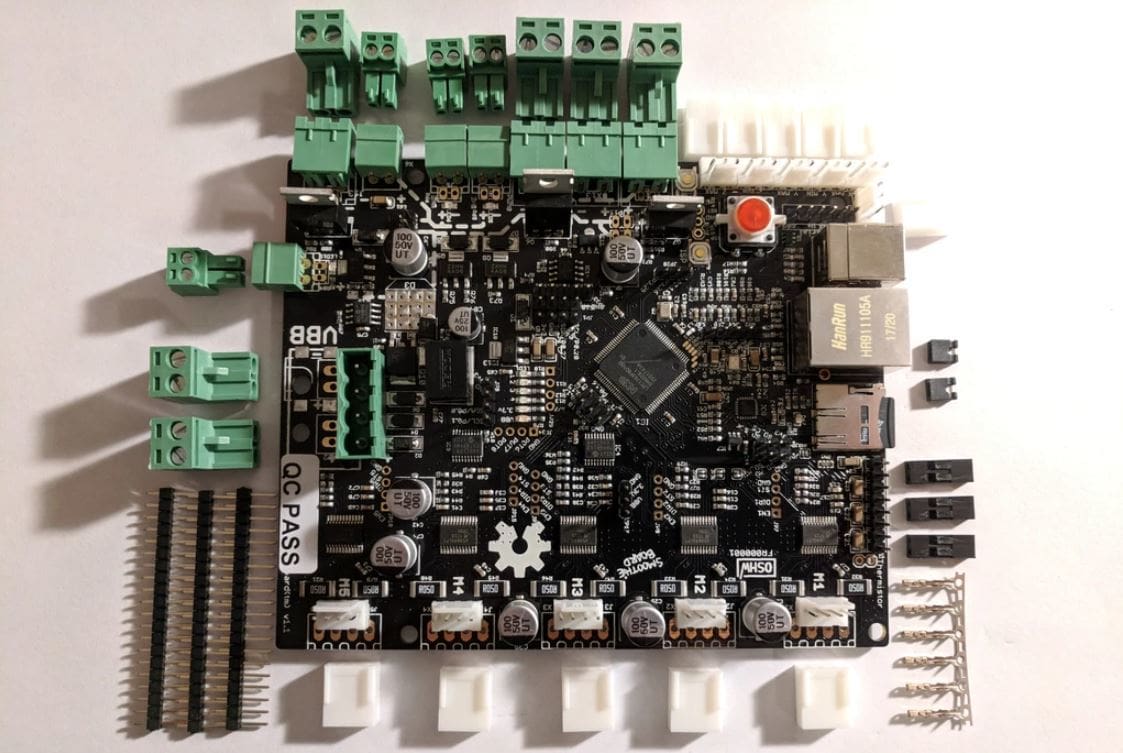
What's Next
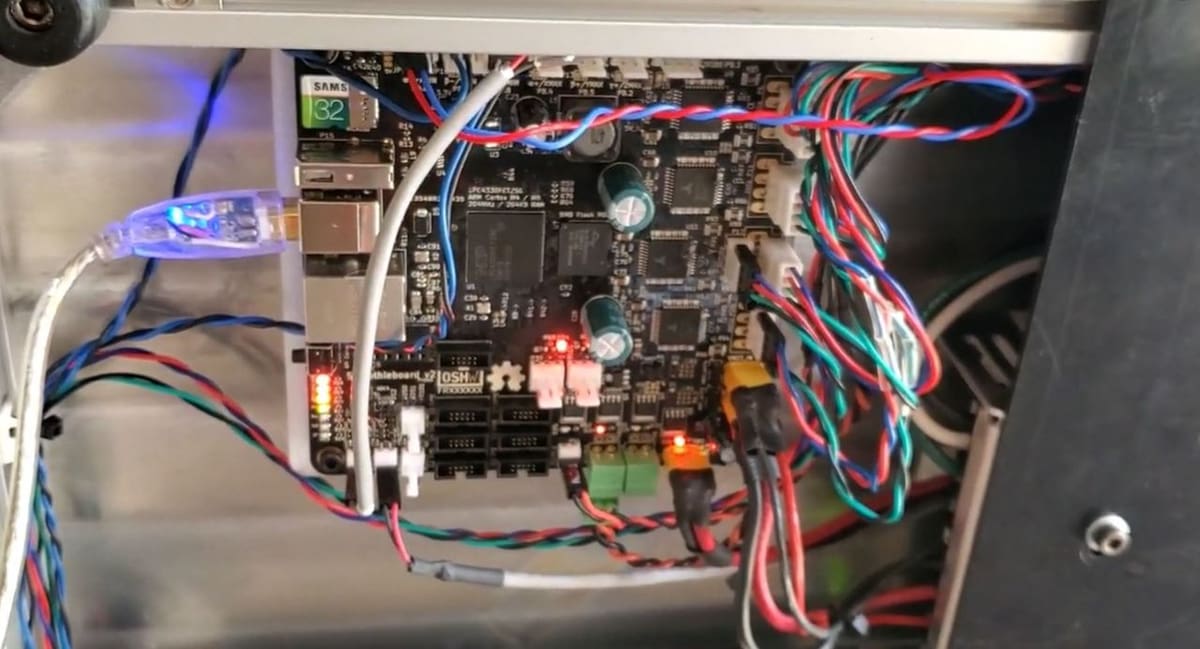
While the Smoothieboard v1 is the ruler of Smoothieware’s line of mainboards, their Smoothieboard v2 may be a worthy competitor. This board aired on Kickstarter in late 2019 and is planned to be an improved version of the v1. While fans can back the project’s development on Kickstarter, the board hasn’t officially been released and is not ready to sell commercially.
So what can we expect with the successor?
To start, the board will have a dual processor unit with an ARM-Cortex M4 and M10 rather than the single M3 in the v1. The v2 processor will have four times the RAM of the v1 and will be very fast with a speed of 240 MHz. The processing unit on the v2 will also have 8 MB of flash memory, which is almost 16 times the flash memory of the v1.
The new board in its standard model will come with TMC2660 stepper motor drivers, a significant upgrade from the Allegro A5984 ones on the v1 board. Speaking of motors, the v2 board will enable 1/256 micro-stepping, which is insanely good.
Smoothieware is cutting down the number of thermistor ports for the v2 board: It will only have three rather than four. You can check out more of the differences on the Smoothieboard v2’s Kickstarter page.
The Smoothieboard v1 is an excellent mainboard for 3D printers and similar machines, but there’s always room for improvement, and the v2 should be an even better version. If you plan to upgrade your mainboard for your machine, you should consider waiting for the v2 to be offered by online retailers. But if the v1’s features suit your needs, it’s likely that the v2 will cost more, so you might want to stick with the older model.
License: The text of "Smoothieboard: Review the Specs" by All3DP is licensed under a Creative Commons Attribution 4.0 International License.
CERTAIN CONTENT THAT APPEARS ON THIS SITE COMES FROM AMAZON. THIS CONTENT IS PROVIDED ‘AS IS’ AND IS SUBJECT TO CHANGE OR REMOVAL AT ANY TIME.

